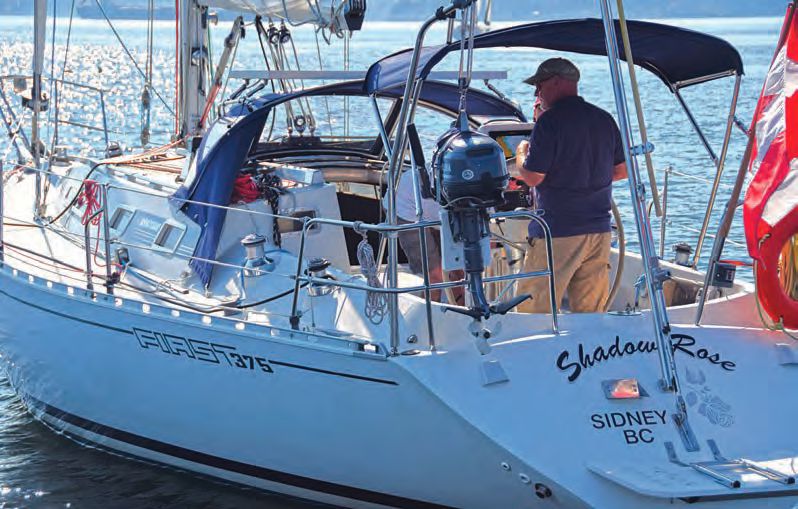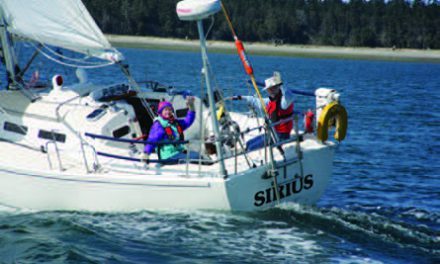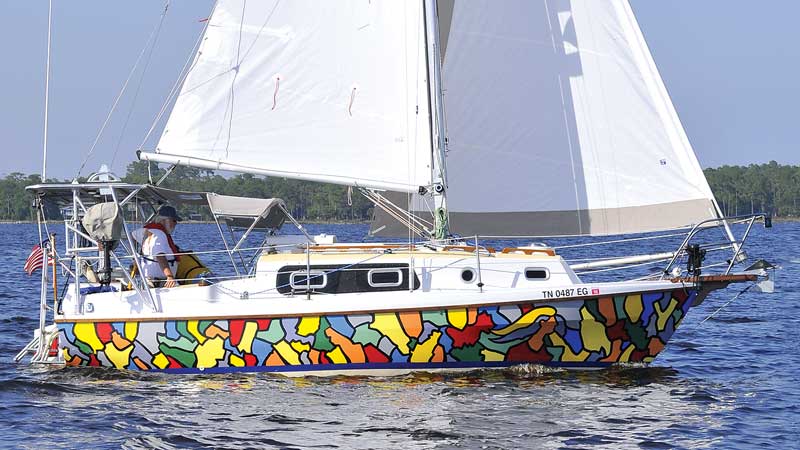A fast and comfortable racer-cruiser that has stood the test of time
Issue 154: Jan/Feb 2024
While on vacation in Mexico, Debbie Bulk dreamed of a better way to see local village life away from the regular tourist destinations. On an idyllic evening stroll near a marina, she and her husband, Hans, caught the reflection of boats on the still water. The idea of vacationing aboard a sailboat began to ferment.

Upon their return to the family greenhouse business near Victoria, British Columbia, Debbie and Hans signed up for midwinter sailing lessons. The search for a sailboat was on, and a Beneteau First 32 opened a lifetime of adventures for the family. The couple gained sailing experience in the Canadian Gulf Islands, north to Desolation Sound, and south to the San Juan Islands in Washington. But with four growing children, the First 32 was getting a little cramped. Liking what they had in the First, they found a 7-year-old Beneteau First 375 in San Francisco, had it trucked north, and named it Shadow Rose.
After racing and cruising in their home waters, the couple cruised south to Baja Mexico for 18 months, making their long-ago dream a reality. As the years went by, they made the jump to the “dark side” by buying a trawler and selling the Beneteau in the fall of 2022 to a friend, Jamie Naismith.
Design
The Beneteau family has been building boats since the 1800s, initially specializing in sail-driven commercial fishing boats designed in-house by family. By the 1950s, small diesel- and gasoline-powered boats were of more interest to fishermen, so Beneteau changed direction and began development of small recreational sailboats, produced in a new material called fiberglass.
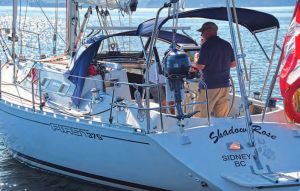
All lines, including the controls for the solid vang and baby stay, are led aft to the cockpit. The baby stay, adjustable
from the cockpit, prevents mast pumping
in heavy seas.
In the late 1970s, Beneteau’s First line of yachts was developed and the company brought in naval architect Jean Berret, a member of the design team for Phoenix, a successful One Ton racer in the Admiral’s Cup regattas of the mid-1980s. Expanding on that design with a cruising interior, Berret introduced the First 375 in 1985. The slippery IOR-influenced hull form was popular with cruising and racing skippers, selling nearly 300 units in a four-year production run. Two interiors were offered. Shadow Rose’s has its galley and salon table to port, a generous double aft cabin, and a voluminous cockpit locker to starboard. The alternate layout has the galley and salon table to starboard, with a single berth aft cabin and a double berth in another aft cabin to starboard. This layout eliminates the cockpit locker but provides three separate cabins. In both options, the head is aft, opposite the galley.
Construction
The hull is handlaid solid fiberglass and polyester resin with reinforcements in the high-stress areas. I suspect that these hulls were fabricated just before the Beneteau factory introduced vacuum bagging as a production process to better consolidate the laminate and reduce excess resin.
Two keel options were offered, Shadow Rose’s 6-foot 5-inch deep fin, and a shallow draft option at 5 feet 6 inches. The keel bolts are accessible in the bilge. Shadow Rose had her excess bottom paint stripped a few years ago, which uncovered only a few minor blisters.
Four substantial hollow fiberglass ribs run athwartships under the teak-and-holly cabin sole, and the sole panels are removable for access to the hull. Two solid longitudinal stringers outboard of the settees run the length of the main cabin and form anchor points for the stainless steel chainplates. With the keel-stepped mast set well aft of the forward bulkhead, the stays are connected to the chainplates with stainless steel rods visible in the salon. Inspection of the chainplates is through cutouts in the cabinetry.
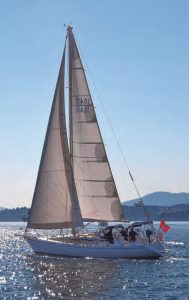
The deck is balsa-cored, with solid fiberglass where the deck hardware is fastened. Backing plates are stainless steel and in most cases accessible. The hull-to-deck joint is an inward-turned flange with the deck set onto a bonding compound and fastened through the aluminum toerail every 4 inches. Hans reports no leaks in this structure over the years, despite some rough offshore sailing.
The forward bulkhead separates the V-berth from the main cabin and is glassed to the hull and deck. Under the forward cabin sole is a fiberglass pan, usable as a sort of shallow storage bin. A 10-inch circular cutout in the subfloor appears to be factory cut, allowing access to the hull for instrument transducers forward of the keel.
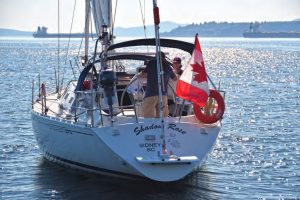
Shadow Rose looks shipshape and ready for another run to Mexico,
with the bimini and dodger providing environmental protection. Note the hoist
for raising and lowering the outboard motor.
Moving aft, there is a partial bulkhead that encompasses the aft head, companionway, and access to the aft cabin. Under the T in the cockpit there is an additional full-width bulkhead separating the cockpit locker from the lazarette at the stern. The engine compartment is separated from both lockers with plywood, keeping storage items away from the engine.
The lazarette has a box-shaped fiberglass structure that holds the rudder post and steering gear — the typical chain and cable-and-quadrant setup. All of these structures appear to be somewhat overbuilt for the size of the First 375. A small blackwater holding tank is located inside the locker as well, but is too small to be useful for any kind of cruising. Replacement with a larger tank mounted in the roomy cockpit locker is the logical solution.
Deck and Rigging
The standard double-spreader, keel-stepped mast rises 49 feet above the deck. A slightly shorter rig (47 feet 6 inches) was matched with the shallow-draft model. The upper and lower stays terminate at the same deck plates set well inboard. Depending on the year of manufacture, a stainless steel double-roller platform was also installed. A vertical windlass was added during the cruise to Mexico, mounted just forward of a deep anchor locker that provides plenty of room for chain and rode.
Halyards and control lines exit the mast to turning blocks at deck level, then out to organizers and back to line stoppers with self-tailing winches at the trailing edge of the coach roof.
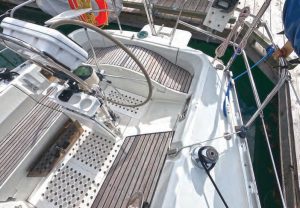
All instruments, and engine and autopilot controls, are easily reached by the helmsperson. The T-shaped seating has a raised helm seat across the lazarette lid, but it is not raised enough to be able to see forward over the coach roof. The best sailing seats are atop the wide coamings.
Genoa sheet tracks are set proud on the deck next to the cabin trunk, extending from the chainplates back to the cockpit. A turning block mounted well aft provides a proper sheet angle to the primary self-tailing winches. The slotted toerail is available for spinnaker blocks, with dedicated self-tailing winches mounted aft on the cockpit coaming.
The boat is rigged with double lifelines and nicely tapered stanchions set in cast aluminum bases against the toerail. The bases have been known to fail and should be monitored for cracks.
A clear Lexan companionway slide, along with three large deck hatches, allow plenty of light and ventilation into the cabin.
Aside from the cockpit seats, the only teak on the Beneteau First 375’s deck is the cabin top handrails. On Shadow Rose, these have been replaced with stainless steel tubes flattened into an oval and mounted on the molded-in bases — stronger than the factory teak handrails and without the maintenance.
The cockpit is small compared with modern designs of the same length. With the tapered stern, the available space narrows near the pedestal and wheel. This works well for bracing feet against the opposite seat, but unfortunately, the vertical coamings have a two-angle shape. Lacking in height, they fail to provide enough back support to be comfortable.
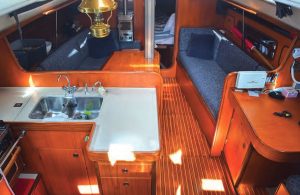
The conventional salon accommodation plan has facing settees, table, teak-and-holly sole, and an L-shaped galley.
The cockpit sole is curved up toward the gunwale at the T, allowing excellent footing for the helm position on the leeward side when heeling. From a personal viewpoint, these curved soles invite twisted ankles until one is familiar with the curve. I much prefer a flat surface, particularly when motoring or stationary.
The 36-inch wheel is readily accessible from the windward or leeward side without having to stretch too far. But it is constantly in the way when at anchor or the dock. Hans fabricated a fitting that enables the wheel to be removed and stowed out of the way when not in use.
The cockpit seats are covered with teak and “tar” strips glued to recesses in the fiberglass lids. Time and exposure to sun have caused the black bedding compound to deteriorate, separating from between the teak strips. It’s an ongoing maintenance issue.
Sails
Recent purchases include a new fully battened main with lazy jacks and 130% genoa. A 90% jib is also available but seldom used in this light-air coastal environment. For sailing through a British Columbia summer, the genoa is quite adequate. An asymmetrical spinnaker flown off the new extendable pole at the bow enhances off-wind performance.
Accommodations
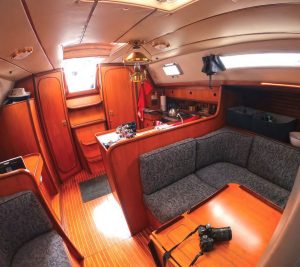
Looking aft from the main bulkhead, the door to the aft cabin is on the port side and the head to starboard.
Climbing over the cockpit bridge into the cabin is like a flashback in time. There is warm teak cabinetry throughout the interior. The U-shaped galley is to port, with a substantial island and countertop on the centerline. Storage above the stove and in the surrounding cabinetry is exceptional, and there is additional storage in an exposed shelf against the hull and a hanging locker. An opening port in the galley provides ventilation. As in many boats of this era, the cabin liners had failed over the years, with the vinyl separating from the open-cell foam glued to the hull and overhead. Aboard Shadow Rose, the liners have been replaced with vinyl and closed-cell foam panels screwed into place, maintaining the original appearance. There is another opening port from the aft cabin into the cockpit.
To starboard of the companionway is the head/shower compartment. A small vanity with a sink and shower wand make this a perfectly serviceable head. Two opening ports provide light and ventilation.
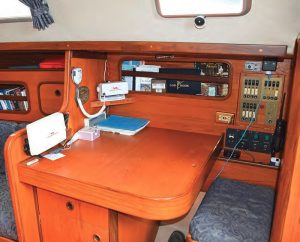
The chart table has limited space for electronics, but most are located at the helm, where they are much handier.
Forward of the head is the dedicated nav station with seat and chart table. There is storage under the seat, in the chart table, and in cubbies.
The main cabin has a U-shaped settee to port, with a large table attached to the mast. A drop leaf services the settee on the starboard side. This arrangement could easily seat six in comfort. Both settees could be considered full-length berths. There is open storage above and behind both settees. A pair of 35-gallon water tanks resides under each, which substantially reduces storage capacity under the settees.
Although Shadow Rose’s ultimate destination was the hot sunshine of Mexican waters, sailing in the Pacific Northwest required some sort of cabin heating, so a Dickinson Newport 1200 propane bulkhead-mounted cabin heater was installed.
Mechanical
Standard propulsion for Shadow Rose was a 2002 Volvo Penta 28-hp diesel with fixed propeller. To reduce drag under sail, a three-blade Kiwiprop composite feathering prop was installed, an economical alternative to expensive bronze feathering-and-folding props. Hans says the Kiwiprop has stood the test of time and sea miles, performing as advertised. The Volvo was still going strong when Hans and Debbie decided to replace it with a Beta 30.
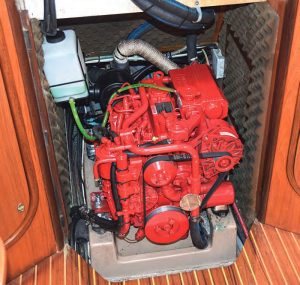
Access to the engine compartment is excellent, with removable companionway stairs and an opening cabinet in the aft cabin.
The three-way hot water tank is located in the roomy cockpit locker. The single starting battery and three group 31 AGM house batteries are under the aft cabin mattress. The refrigeration unit is located in a locker behind the port settee.
For the Mexico cruise, a Raymarine wheel autopilot was installed. Although pushing the 18,000-pound limit for the autopilot, it performed as expected, with hand steering required in stormy conditions. Since then, a Raymarine belowdecks autopilot has been installed and has worked flawlessly.
Underway
Pulling away from the dock at idle, the Beta diesel was a distant murmur in the well-insulated engine compartment. With a deep fin keel and large spade rudder, Shadow Rose behaves as expected in close quarters, infinitely maneuverable with only a hint of prop walk. Powering up to 2,800 rpm delivered 6 to 6.5 knots, with plenty of rpm in reserve to attain the 7.7-knot hull speed. Adding a secondary “muffler,” such as a Centek water separator, would reduce the exhaust noise considerably without increasing back pressure.
Although not a modern lightweight flier with a large flat run to the wide stern to enhance off-wind performance, the Beneteau First 375 heels slightly and settles into a groove to sail effortlessly to windward. Perched on the wide sidedeck with the large wheel readily at hand, watching the genoa telltales, the helms-person has a fabulous view forward. Sitting on the leeward side is a bit more challenging. The canted sidedeck makes sitting upright difficult. Using the stern pulpit as a backrest is the solution. Although not likely to surf down waves off the wind, the First 375 performs admirably.
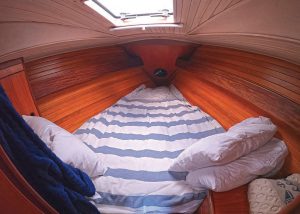
Like many other boats with narrow ends, the V-berth is wide at the head and narrow at the foot. With the failure of the vinyl liner on both the hull and overhead surfaces, oak and ash slats were installed over closed-cell foam.
I was pleasantly surprised at Shadow Rose’s acceleration and speed going to windward. Reaching and running were a challenge in the light breeze, but she continued steadily through powerboat wakes without slowing. The helm was light and sensitive to the touch.
For comparative speed, the PHRF number for the Beneteau 375 is about 111 seconds per mile in most fleets around the country, while two other designs of similar age, the J/37 and Tartan 37-2, rate around 72 and 144, respectively.
Conclusion
I consider the Beneteau First 375 a near-perfect coastal cruiser for inland waters, with proven offshore capabilities. The ability to go to windward or run with the wind is of paramount importance in most coastal areas, where prevailing winds follow the coastline. A boat either sails well in these conditions or motors extensively. The Beneteau First 375 succeeds in the sailing part of that equation.
From an interior layout that is pleasing to the eye and roomy enough for four (but perfect for two), to the wide sidedecks and low coach roof that provide for safe and easy access to the deck, the Beneteau First 375 is a classic good old boat that seems to have slipped by unnoticed.
A number of 375s are currently listed for sale online, with most asking in the $50,000 range.
Bert Vermeer and his wife, Carey, live in a sailor’s paradise. They have been sailing the coast of British Columbia for more than 40 years. Natasha, an Islander Bahama 30, is their fourth boat (following a Balboa 20, an O’Day 25, and another Islander Bahama 30). Bert tends to rebuild his boats from the keel up. Now, as a retired police officer, he also maintains and repairs boats for several nonresident owners.
Thank you to Sailrite Enterprises, Inc., for providing free access to back issues of Good Old Boat through intellectual property rights. Sailrite.com

